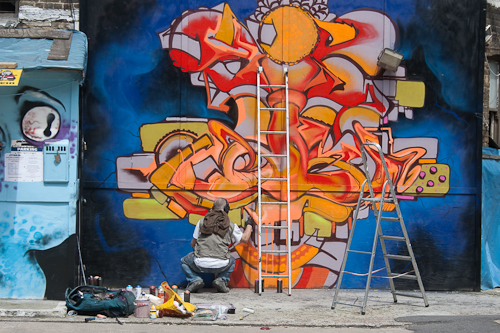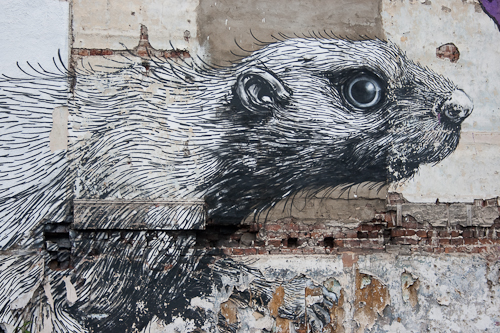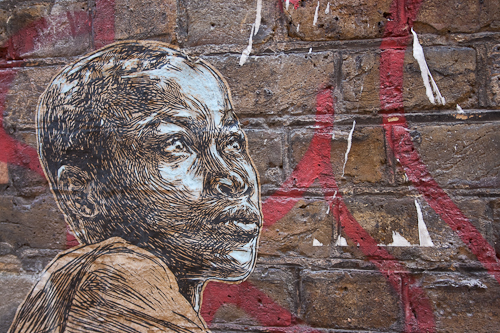 London is front and centre right now. With the Olympics underway, the world will get a chance to see results of the extensive regeneration this top-notch city’s East end underwent in order to host the Games. That area has long been known for being gritty, rough around the edges, and for its proliferation of artists and graffiti. Like anywhere, the future of much of its diversity and creativity is perhaps uncertain, as ‘gentrification’ is often synonymous with ‘regeneration.’ Time will tell how successful the developing areas will become.
London is front and centre right now. With the Olympics underway, the world will get a chance to see results of the extensive regeneration this top-notch city’s East end underwent in order to host the Games. That area has long been known for being gritty, rough around the edges, and for its proliferation of artists and graffiti. Like anywhere, the future of much of its diversity and creativity is perhaps uncertain, as ‘gentrification’ is often synonymous with ‘regeneration.’ Time will tell how successful the developing areas will become.
Richard Griffin knows East London’s street art scene inside out and he, or one of his disciples, regularly conducts jam-packed 4hr walking tours through the Shoreditch neighbourhood. ‘Griff’ leads the troops along lanes and back alleys, identifying all sorts of graffiti types (tags, characters, big walls) by introducing visitors to the works of over 40 local and international artists. Some figure prominently in areas of high visibility while others are so obscure they need to be pointed out.
Unless specifically commissioned, elusive artists work in complete anonymity and often late at night. After all, graffiti is illegal. “It is a premeditated, and sometimes highly organized, form of vandalism with a very well-developed sub-culture behind it.”* Sometimes this form of free expression is used to draw attention to decaying or neglected spaces. Oftentimes it is motivated by a desire for fame, be it statement-making (think Banksy’s satirical public works) or gallery promo. [Side note: street artist Ben Wilson has cleverly evaded prosecution with a very bizarre and unique approach. If you’re lucky you’ll spot him sprawled on the sidewalk, painting flattened gobs of chewing gum. It’s all good though – he’s merely transforming existing rubbish into thousands of miniature paintings.] More ‘typical’ graffiti styles you’re likely to see include: Bubble, Fat Cat, Splash, Block, and Wildstyle.
Some pieces are very involved while others are quick and dirty. Some cover an entire wall while others are just small markings lurking low in corners or high on walls (think pixel characters by Invader) that, in the immortal words of Ferris Bueller, “if you blink you could miss it.” Many artists have instantly recognizable styles: Dutchman Roa’s black and white ordinary animals with their focal gaze occupy abandoned lots; New York-based Swoon’s paste-ups created from wood cuts are realistic in style; and, Catalonian Pez’s hyper fish and other characters charm with their infectious smiles. And again there’s Banksy. Works by this protected artist who capitalized on getting really good images up fast by using stencils (considered ‘cheating’ by some) are preserved behind Plexiglas because of their popularity and consequent boosting of property value.
There are various kinds of graffiti artists. There are the widely known ones, there are those who make a good living off their work, and then there are unknown artists, who are neither bothered by money or ambition or are just starting out. Common now are commercial artists that want to work on the street and alternatively, street artists that want to get into galleries. Biggies like Stik –who paints simple stick figures (read: fast) that convey great emotion – are lucky to be living the dream: to travel the world doing one’s art. But more than shoptalk, Griff also shares some of the seedy goings on in the street artists’ worlds: the liaisons, the affairs, and most interestingly, the feuds. Work is vulnerable to being taken out by rival teams or ‘barnacled’ by others in an attempt to siphon off attention. It’s a colourful tour, in more ways than one.
London’s street art scene is constantly changing and Griff knows where the latest and greatest is to be found. Whether it’s from trolling the streets in search of goodies or hits from artists posting their new pieces on Twitter or Facebook, Griff keeps his list updated regularly. Works still hanging around after 2 months are considered ‘old’ here and are “gone over by other artists or buffed away by the Council.”
If you didn’t ‘get’ the world of street art before, you will after this tour because the artwork is the kind of thing that’s best experienced in person. You’ll know your ‘throw-ups’ from your ‘bombs’, a Stik from a Swoon, etc. It now has me looking high and low to scout out and interpret new ones in my own city, Toronto. There’s nothing like being greeted by a giant painted toaster on your way to work.
Tours are available Tuesdays, Saturdays and Sundays. Contact Street Art London to book at http://streetartlondon.co.uk/tours/.
*Richard Tawton occasionally gives graffiti tours in Toronto








